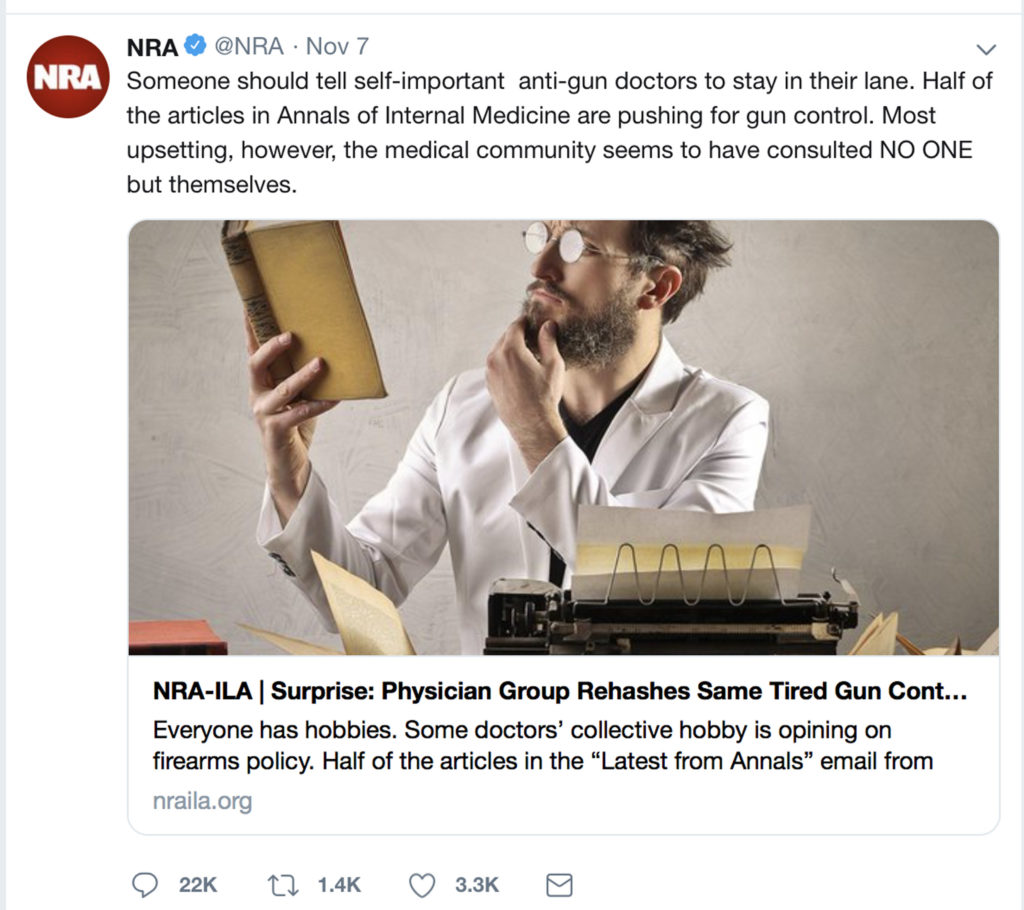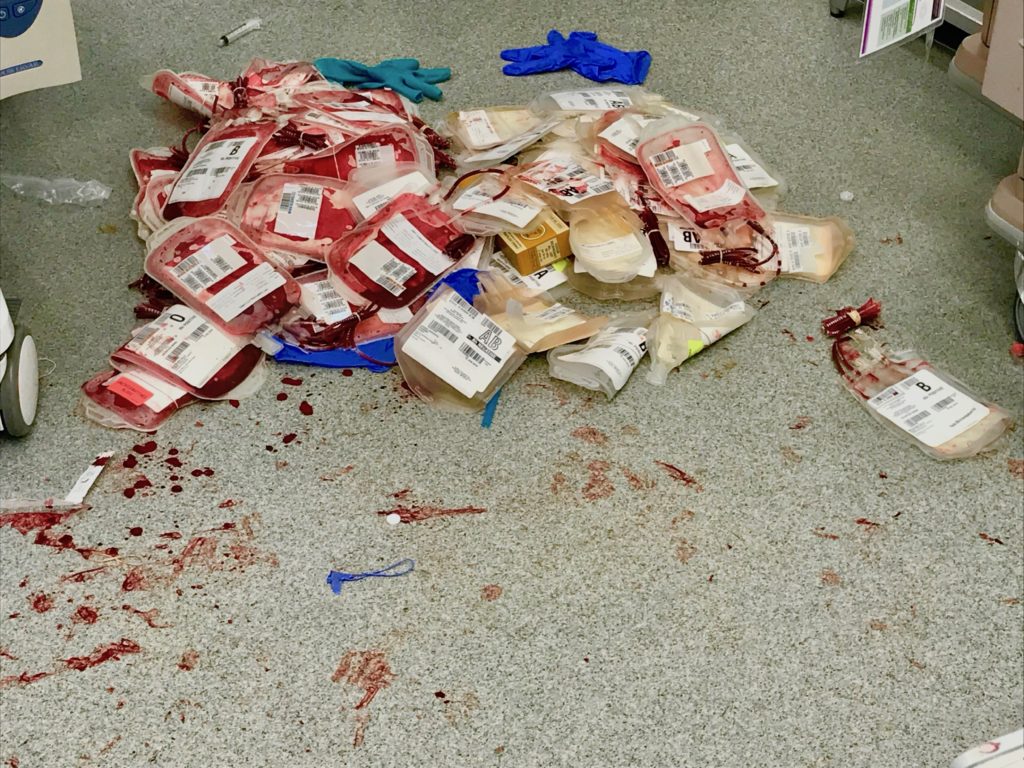by Craig Klugman, Ph.D.
Since January 1, 2018 through November 15, the United States has seen 311 mass shootings that have killed 339 people and injured 1,249. The Centers for Disease Control & Prevention (CDC), shows that gun deaths are on the rise (mass shootings, all shootings, accidents, suicides, etc.). Shootings are the third leading cause of death in children aged 10-19 years and are responsible for 74% of all homicides. Having a gun in the home is a risk factor for death by gun whether accidental, deliberate, or unintended (a person with Alzheimer’s, a child playing). According to the Harvard Injury Control Center, there are 265 million guns in the hands of civilians (the entire US population is about 320 million).
In the latest brouhaha, the National Rifle Association (NRA), tweeted on November 7 that “Someone should tell self important anti-gun doctors to stay in their lane” in a complaint about a series of articles in the Annals of Internal Medicine. The Annalspaper was a report from the American College of Physicians with suggestions to “address firearm-related injuries and deaths in the United States.” The paper recommends viewing firearms injuries as a preventable public health issue, bringing experts together to discuss “social and legislative change,” and to encourage physicians to counsel patients “on the risk of having firearms in the home, particularly when children, adolescents, people with dementia, people with mental illnesses, people with substance use disorders, or others who are at increased risk of harming themselves or others are present.” Further statements encourage the use of evidence when developing legislation and regulation (such as that the presence of guns do not deter crime, ensuring access to mental illness counseling, and to support legislation that bans “semiautomatic firearms” (a.k.a. assault weapons, large- capacity magazines outside of military use)).

The NRA is a manufacturer’s lobbying organization. Their job is to increase the sales of weapons so that their member companies make more profits. That is their entire reason for being. To achieve that aim, they developed the brilliant marketing campaign that they are the defenders of the Second Amendment (“A well regulated Militia, being necessary to the security of a free State, the right of the people to keep and bear Arms, shall not be infringed.”). In response to mass shootings they have placed the blame on mental illness (not the presence of guns) and have recommended that people would be safer if there are more guns in the hands of “good people” including teachers (Although, a recent story shows that “good guy” means “white guy” when police officers shot a security guard holding a shooting suspect; thus reinforcing that the gun debate in the U.S. is rooted in historic racism). Notice that all of these responses have the effect of increasing the sales of guns and forcing others (mental illness providers, schools, homeowners, church goers, concert attendees, moviegoers) to take responsibility for shootings. The one place that this manufacturer’s organization does not ever place blame is on guns.
Thus, the NRA’s effort to blame doctors for wanting to view gun shootings as a public health issue was to tweet that doctors should “stay in their lane.” The reaction to this bullying was nothing less than stunning by the medical community. As of Tuesday (Nov 13), there were over 21,000 responses to the NRA from health care providers. Physicians and nurses have responded with #InMyLane/#ThisIsMyLane/#ThisIsOurLane, sharing stories of taking care of the victims of gunshots. They tell stories of people struggling to recover after a gunshot. They tell stories of patients dying on their operating tables. And they showed pictures, so many pictures, of their scrubs drenched in blood, of their face masks splattered with blood, and of floors covered in the bloody remains of supplies used to try and save gunshooting victims. Many of these pictures are accompanied by statements that the image was taken so as to preserve the patient’s privacy.

Let’s face it, if over 36,000 people each year were being killed by automobiles, there would be a call to redesign them. If a food item caused 36,000 illnesses each year, it would be pulled from the shelves. More people die from gun-related causes than from renal disease or Parkinson’s. More people die from firearms than from motor vehicle accidents and vehicles are highly regulated, regularly inspected, and require a license, registration and insurance to use, and are heavily policed. Public health approaches to countering problems like automobile deaths, food poisoning, and even deaths by infectious disease have reduced the morbidity and mortality of the community, in part by being a check on the power of industries that benefit from the sales of more: more food that is not necessarily stored well (think selling cheese or milk past its expiration date), more cars that are cheaper and easier to manufacture (minus safety features). It was only in 1966 that the U.S. government required cars to have seat belts, an action that has saved tens of thousands of lives and something that car companies probably would not have done on their own. We need a public health approach to guns to help save lives and prevent injury, but also because onlythe police power, resources, and authority of public health can reign in industries that pose a threat to human health.
What can bioethics do?
About every two years, I post a blog on this site talking about the problems with gun shootings and asking where is the bioethics response (see 2018 here; 2016-1 here, 2016-2 here; 2014 here; 2012 here). This year I can report there has been more happening. One of the plenary talks at the American Society of Bioethics & Humanities by Jonathan Metzl talked about America’s gun addiction in “American Firearms and Mass Shootings: Mental Illness, Politics, and Policies”. While PubMed still only shows 11 articles under “guns” and “bioethics”, one of those has a 2018 date. That article by Jones et al in the AMA Journal of Ethicsholds that physicians have a role in the debate over guns and in reducing gun violence, but they should not be assessing the competency of people to purchase guns.
For the end of 2018l, I propose 6 simple bioethics responses to the gun violence crisis:
- Most people in bioethics are not in the frontline of dealing with gun violence. But, we are supporters of the hospitals and health care providers where we teach and consult. We can help support those who deal with this carnage.
- Although the ASBH does not take stands on issues, there are other organizations and on our own, we can craft letters of support to our elected legislators asking them to permit CDC and NIH research on gun violence, to adopt a public health approach to gun violence, and to vow not to take any funds from the NRA or gun manufacturers.
- While one talk at ASBH is a start, we should be conducting ethical analyses and making these public. The Hastings Center Bioethics Forum had two blogs on gunsin March of this year, but it would be great for a bioethics think tank to undertake a project into addressing gun violence.
3a. Good ethics starts with good facts and remarkably, there are surprisingly few good sets of data in this question. Harvard works with a survey they distribute. The CDC is working off of death certificates and voluntary reports. But most scholars and experts believe that the number of firearm related deaths and injuries are woefully undercounted.
3b. One of the NRA standard statements is that the Second Amendment cannot be abridged, but why not? Nearly every other right guaranteed in the Bill of Rights has limits. I can’t yell “fire” in a crowded theater even though I have a First Amendment right to free speech. I can’t tell lies about someone (slander, defamation, and libel) and pass them off as true. The state can’t walk into your home and search through your belongings (Fifth) unless they have a warrant and cause for believing you have done wrong. In many states, even the right to vote has limits (if you were a felon, or your signature does not match, or your address does not match).
- Speak up against social injustice. Although talking about social injustice has been more a health humanities than bioethics issue, it is truly a human issue. Pointing out cases of structural injustice are all of our responsibilities. Even better is working with our communities to combat it.
- For those involved with hospitals, help your institution to craft a policy to support physicians in asking about guns in the home. With the data clearly showing that guns in the home increases the risk of injury and death by a gun (and no increase in the chance of deterring a crime), this falls fully in the lane of human health. Doctors ask about smoking, alcohol use, using a seat belt in a car, and they should ask: Is there a gun in the home? How many? Do you keep it loaded? How is it stored? Who has access? For children and people with diminished capacity, the risk of unintended harm is high (more than half of people over age 65 have a gun in the home). A recent NPR piece talked about the particular risk of guns in the homes of people with dementia who may not always be aware of their actions. The risk is greater for the people who live with these patients. Although many complain about the challenge of talking to one’s parents about when it’s time to stop driving, the conversation about when it’s time to get rid of the guns may be even harder.
- For those of us who teach about the great issues in bioethics classes, we need to emphasize more the ethical dilemmas of public health, social injustice, and yes, gun violence. While cloning, neuroscience, and familial DNA searches might be gripping, those effect a relatively few number of people compared to more general public health concerns. What makes gun violence a unique case study is that the deaths are 100% preventable. A Millsian, Kantian, or Ethics of Care analysis of that would be most enlightening to our students.
Some critics of this approach might suggest that I am advocating stigmatizing gun ownership and undermining the Second Amendment. To be frank, I am fine with both. The norm should not be that people have devices whose proper use is injuring others (unlike a car whose proper use is transportation). Public health campaigns to stigmatize habits (in particular smoking) have been highly effective I reducing morbidity. As for the second, as I explained above, every right has a limit.
The NRA should stay in its lane instead of trying to influence policy and politicians to make society less safe. Stay in my lane? Only when you stay in yours.